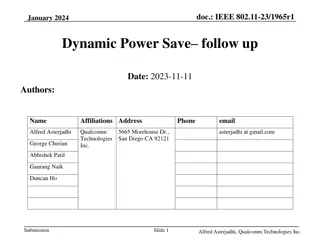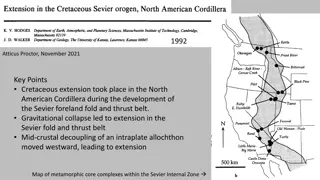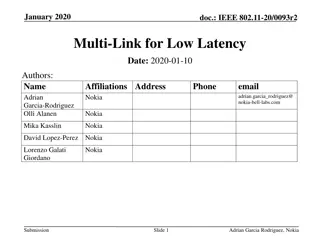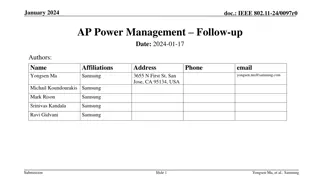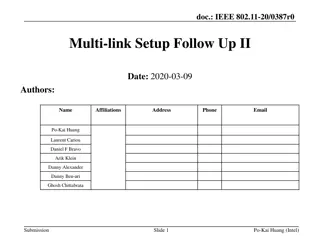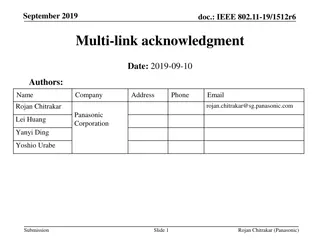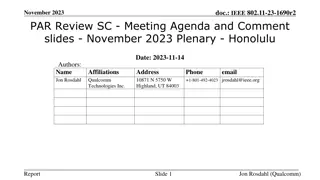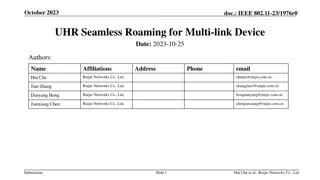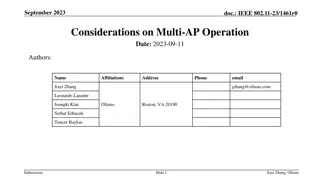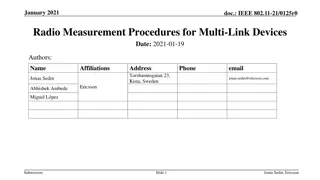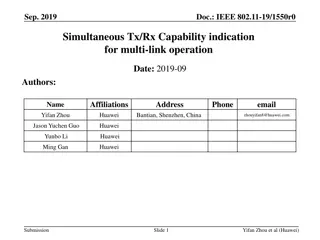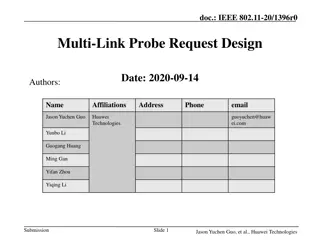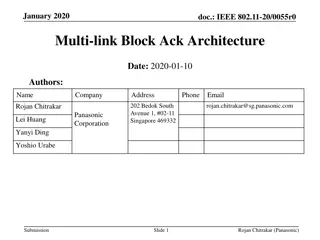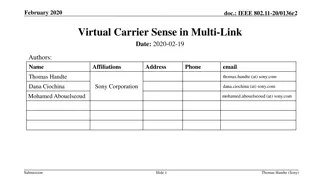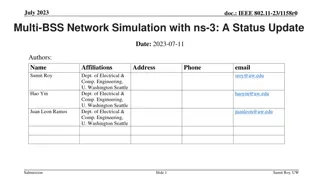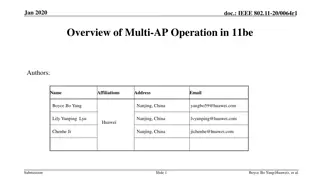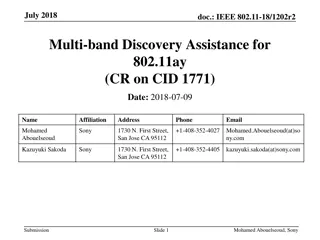IEEE 802.11-20/0760r0 Multi-Link Power Save Mode Extension
This document discusses the extension of dynamic SM power save mode to multi-link scenarios in IEEE 802.11-20/0760r0. By allowing non-AP STAs to control power consumption efficiently in multi-link operations, benefits such as higher peak throughput and increased reliability can be achieved. The dynamic SM power save mode enables STAs to switch between multiple receive chains based on traffic load, optimizing power usage without compromising performance.
Download Presentation

Please find below an Image/Link to download the presentation.
The content on the website is provided AS IS for your information and personal use only. It may not be sold, licensed, or shared on other websites without obtaining consent from the author. Download presentation by click this link. If you encounter any issues during the download, it is possible that the publisher has removed the file from their server.
E N D
Presentation Transcript
doc.: IEEE 802.11-20/0760r0 Multi Link SM Power Save Mode Date: 2020-04-29 Authors: Name Affiliations Address Phone email Jason Yuchen Guo Huawei Technologies guoyuchen@huaw ei.com Yunbo Li Guogang Huang Ming Gan Yifan Zhou Yiqing Li Submission Slide 1 Jason Yuchen Guo, et al., Huawei Technologies
doc.: IEEE 802.11-20/0760r0 Introduction Multi-link operation will bring a lot of benefits, including higher peak throughput, lower latency, increased reliability, etc. On the other hand, due to the use of multiple RF chains, multi-link operation will also bring higher power consumption. In the baseline SPEC, we have the dynamic SM power save mode to control the power consumption when the traffic is light loaded. In this contribution, we extend the dynamic SM power save mode to the multi- link scenario to decrease the power consumption of multi-link. Submission Slide 2 Jason Yuchen Guo, et al., Huawei Technologies
doc.: IEEE 802.11-20/0760r0 Recap Dynamic SM Power Save Mode The dynamic SM power save mode allows a non-AP STA to operate with only one active receive chain for a significant portion of time. An SM Power Save Frame shall be transmitted to enter the dynamic SM Power Save Mode. In dynamic SM power save mode, the STA switches to the multiple receive chain mode when it receives the frame addressed to it and switches back immediately when the frame exchange sequence ends. Such a frame exchange sequence shall start with a single-spatial stream individually addressed frame that requires an immediate response. Multiple Receive Chains Single Receive Chain Single Receive Chain Multiple Receive Chains ACK RTS/ Data Data Data AP SM Power Save Frame CTS/ BA BA BA STA Submission Slide 3 Jason Yuchen Guo, et al., Huawei Technologies
doc.: IEEE 802.11-20/0760r0 Recap HE Dynamic SM Power Save Mode The non-AP HE STA may enable its multiple receive chains if it receives a Trigger frame, including MU-RTS Trigger frame BSRP Trigger frame BQRP Trigger frame The STA switches to the multiple receive chain mode if it receives the Trigger frame addressed to it as defined above and switches back immediately after the frame exchange sequence ends Multiple Receive Chains Single Receive Chain Single Receive Chain Multiple Receive Chains ACK Trigg er Data Data AP SM Power Save Frame respo nse BA BA STA Submission Slide 4 Jason Yuchen Guo, et al., Huawei Technologies
doc.: IEEE 802.11-20/0760r0 ML SM Power Save Mode After multi-ink setup, the non-AP STA can use multiple links and multiple RF chains to communicate with the AP However, when the traffic load is not so high, the non-AP STA can keep only one link active with only one RF chain, other links can be turned off Once the AP has data to transmit to the non-AP STA, the first frame shall be transmitted with single link and single stream, then the non-AP STA shall switch to the multi-link multi-RF chain state The non-AP STA can switch back to single-link and single-RF chain immediately after the frame exchange sequence ends Single-link Single-RF chain Multi-link Multi-RF chain Single-link Single-RF chain Multi-link Multi-RF chain AP1 ACK RTS/D ata/TF Data Data link1 CTS/B A/resp BA BA ML SM Power Save Frame STA1 Data Data AP2 off off link2 BA BA STA2 Note: AP1 and AP2 belong to the same AP-MLD ; STA1 and STA2 belong to the same non-AP MLD Submission Slide 5 Jason Yuchen Guo, et al., Huawei Technologies
doc.: IEEE 802.11-20/0760r0 ML SM Power Save Mode Question 1: when the non-AP STA switches to the multi-link multi-RF chain mode, which links should the non-AP STA turn on? Option 1: turn on all the enabled links Easy, but consumes more power Option 2: turn on the links which are mapped by the TIDs of the corresponding DL data frames. Power efficient, the AP needs to tell the non-AP STA the TIDs of the DL data Option 3: the AP can tell the non-AP STA which links to turn on Power efficient, the AP needs to tell the non-AP STA the links that it is going to use We prefer option 3, and OK with option 1 and 2 Submission Slide 6 Jason Yuchen Guo, et al., Huawei Technologies
doc.: IEEE 802.11-20/0760r0 ML SM Power Save Mode Question 2: How to determine the frame sequences on multiple links have ended? Option 1: Link-by-Link determination Each link can be switched off if one of the following happens It receives an individually addressed frame addressed to another STA. It receives a frame with a TA that differs from the TA of the frame that started the TXOP. The CS mechanism indicates that the medium is idle at the TxPIFS slot boundary (counting from the time that the STA starts receiving its own frames). Drawback: limitation on cross-link retry Option 2: define a new Multi-link More Data bit. Indicates the DL data on all links are finished or not Can be carried in the MAC header (HT control field) We prefer option 2, and OK with option 1 Submission Slide 7 Jason Yuchen Guo, et al., Huawei Technologies
doc.: IEEE 802.11-20/0760r0 Conclusion We propose a multi-link SM power save mode in this contribution Single link and single stream is enabled after entering the ML SM power save mode Multi-link and multi-stream will be activated when the DL data frames arrive. Submission Slide 8 Jason Yuchen Guo, et al., Huawei Technologies
doc.: IEEE 802.11-20/0760r0 Straw Poll 1 Do you support to define a Multi-link SM Power Save Mode as in slide 5? Submission Slide 9 Jason Yuchen Guo, et al., Huawei Technologies

















